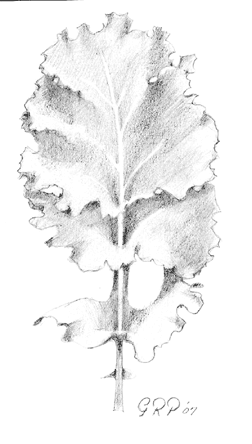|
|
 |
||||||||||
|
|||||||||||
|
|||||||||||
Kale Comes into Its OwnThis time of year, it’s good to look at and good to eat
The kale patch is really coming into its own now. Planted in the early spring, it complimented the other spring greens but went largely unused because we had plenty of lettuce and spinach. Over the summer, caterpillars called cabbage loopers feasted on the leaves, turning them to lace, but that was okay because we had Swiss chard for a leafy green to go along with all of the hot-weather vegetables in the garden. During that period, we tried to imagine life without fresh tomatoes served with cucumbers and basil. The kale went ignored, except by the loopers. Since then, chilly nights have shut down production of tomatoes, beans and cucumbers. At the same time, our cravings for those foods have diminished. Meanwhile, the kale plants grew well in the warm fall weather. Now we have an abundance of frilly, blue green leaves, and our cravings have turned more toward hearty soups and stews seasoned with kale and parsley. Soon, nighttime temperatures will dip below freezing, but that is all the better for kale because cold improves the flavor by making it slightly sweeter. The plants will survive without protection down to about 10 degrees. Kale is so hardy that it can be planted in a cold frame as late as Thanksgiving. Kales and cabbages are closely related and are among the most nutritious and easy to grow vegetables in the garden. Domesticated kale originated in the eastern Mediterranean area thousands of years ago. Because it is nutritious, grows so readily and tolerates cold so well, the crop was exported far and wide. Redbor and Winterbor are both varieties that I have had success with in my garden. We recently made potato soup with kale, and it was delicious. The main ingredients were half a medium onion, three stalks celery, six small white potatoes, a can of chicken stock and about two cups of kale. Sausage, non-fat dry milk and parsley are optional ingredients. Simmer all the ingredients, except the kale, until the potatoes become soft and the soup turns thick, about 40 minutes. Next, add a quarter cup of non-fat dry milk (or a dose of real milk) and a tablespoon of butter or margarine along with the kale. The kale wilts in about one minute and it is ready. Serve it with hot corn bread and a glass of porter, and you’ll be doing pretty good by my standards. |
|||||||||||
|
|||||||||||
|
|
|||||||||||
|
© COPYRIGHT 2007 by New Bay Enterprises, Inc. All rights reserved. |
|||||||||||

